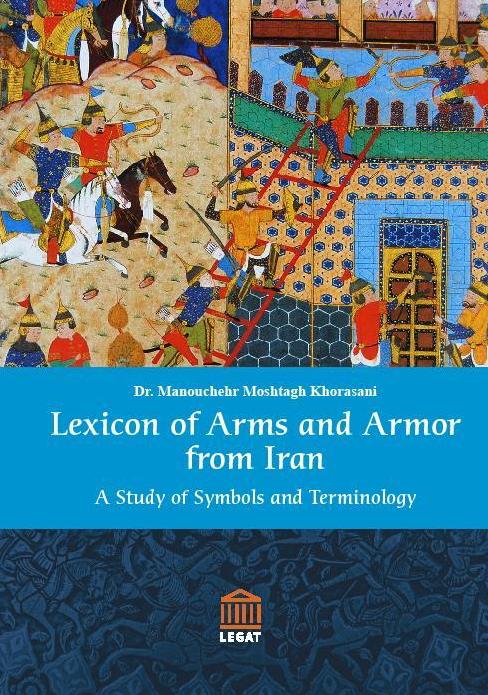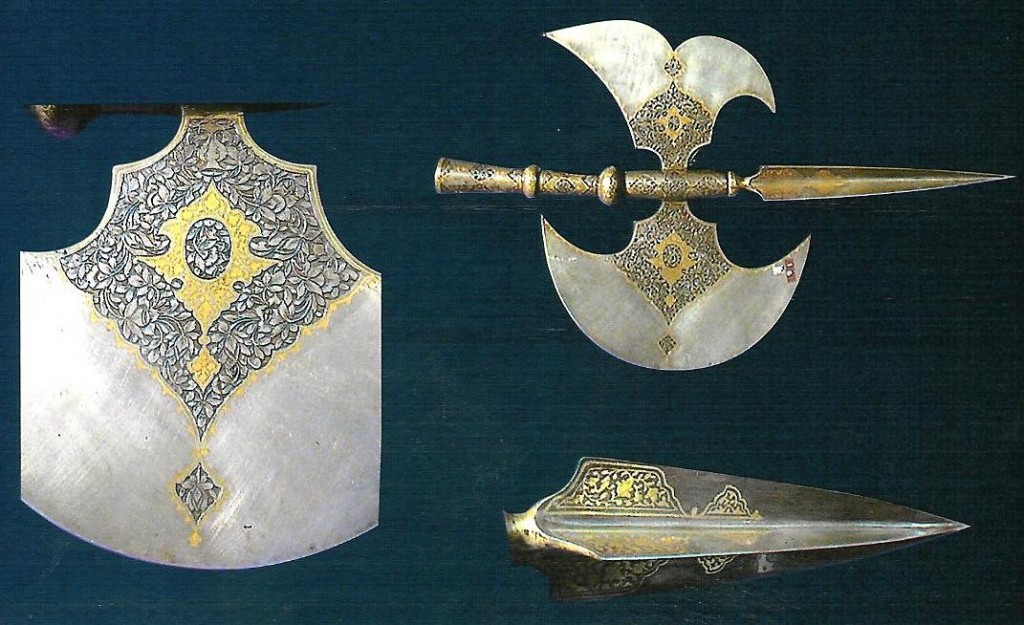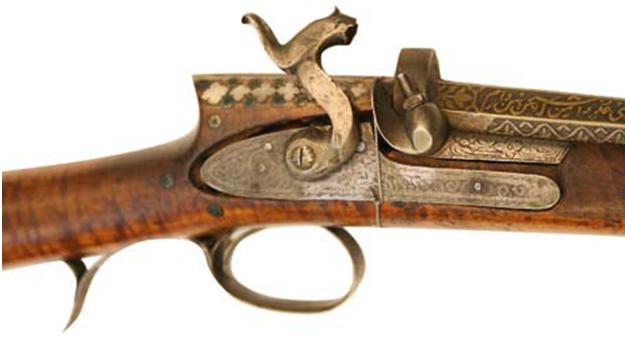An excellent new and comprehensive textbook has been published pertaining to Iranian military history and terminology:
Lexicon of Arms and Armor from Iran: A Study of Symbols and Terminology
Author: Dr. Manouchehr Moshtagh Khorasani
Publisher: Legat Publishers (Tübingen, Germany) (2010)
ISBN: 978 0 96276 645 9
To Order click on the Legat Publishers link or order directly from LEGAT Publishers: Alexander Frank ([email protected])Tel. +49 (0) 70 73 / 30 24 49; Mobile +49 (0)179 / 453 61 21
The book has already elicited a number of highly supportive reviews; including the one posted on the Persian Mirror Magazine. This book is an excellent companion to Dr. Khorasani’s Arms & Armor from Iran: The Bronze Age to the End of the Qajar Period published in 2006. Dr. Khorasani’s books are indeed in the tradition of great scholars of Iranian Studies such as the late Roman Roman Ghirshman’s “Iran: Parthians and Sassanians” (1962). Dr. Khorasani’s books have also set the standard of academic excellence in the domain the military history of Iran.
With over 5700 entries, the book Lexicon of Arms and Armor from Iran: A Study of Symbols and Terminology provides a sound and solid base of terminology of arms and armor in Persian so that military historians, historians, museum curators, researchers and collectors and also people interested in reading historical accounts and epic stories would be able to understand and use the appropriate terms related to each certain type of weapons.
A double-headed Sar-e-Tabar (axe-head), of the late Safavid era. Dr. Khorasani is the first researcher to make an exhaustive compilation of all ancient Iranian arms from the bronze age to the present. The vast majority of the photgraphs that Dr. Khorasani provides in his 2006 Arms and Armor book have never been seen by Western researchers or venues. Christie’s of London now uses Dr. Khorasani’s 2006 text as a standard reference (Picture Source: Khorasani, Arms and Armor from Iran: The Bronze Age to the end of the Qajar Period. Legat Verlag, 2006, pp.662).
Persian culture and civilization is a fascinating old culture. Therefore, all major types of the Persian language are taken into consideration, namely, the Avestan, the Old Persian, the Middle Persian (Pahlavi), and the New Persian. Next to each entry which is written in its phonetic alphabet, the original script is provided as well. Therefore, there are four different phonetic alphabets provided for each type of script. Next to each entry, after the phonetic alphabet and original script, the type of Persian language is identified as (Avestā), (Old Persian), (Middle Persian/Pahlavi) or (New Persian). Additionally, Kārnāme-ye Ardešir Bābakān
The lexicon provides the following categories of words and expressions:
a) all types of offensive weapons, such as swords, maces
b) all types of defensive weapons, such as shields, armor
c) techniques employed by each weapon, such as striking the top of the head with a sword
d) forging techniques, materials used in making crucible steel cakes and forging, and terms related to watered steel
e) different types of horses because horses were used by the cavalry in the battle
f) all horse-related equipment, such as harness
g) siege weapons, such as catapult
h) other types of animals used on the battlefield, such as elephants and camels
i) terms related to the warrior codex of javānmardi
j) terms related to the traditional Persian martial art of varzeš pahlavāni and its related tools
k) wrestling techniques
l) metals and stones used as decorative elements in arms and armor such as gold and precious stones
m) terms related to fighting and warfare, such as attack
n) historical firearms, such as matchlocks and flintlock guns
The present lexicon uses the holy book of the Avestā for the Avestan terms as it provides a good source for the terminology related to the arms and armor in this old language. The holy book of the Avestā presents a marvelous description of an array of weapons used by different deities in the battlefield. For arms-and-armor-related terms in Old Persian sources, the following inscriptions in cuneiform are used: a) the inscriptions of Dāryuš Bozorg in Bistun, b) the inscription of Dāryuš Bozorg in Šuš (Susa), c) the inscription of Dāryuš Bozorg in Naqš-e Rostam, d) the inscription of Dāryuš Bozorg in Suez, e) the inscription of Dāryuš Bozorg in Taxt-e Jamšid, f) the inscription of Xašāyāršāh in Taxt-e Jamšid, g) the inscription of Ardešir II in Šuš, and h) the golden tablet of Aršām, Hamedān. For terms in the Middle Persian, the treatise Kārnāme-ye Ardešir Bābakān [The War Treatise of Ardešir Bābakān] (2007/1386) was used as a source.
A close-up of an Iranian-built firearm from the Zand era; note British percussion cap mechanism. Dr. Khorasani is also the first researcher to provide a comprehensive study of Iranian-built muskets and guns (Picture Source: Khorasani, Manouchehr, Mosthagh (2009), Persian Firearms Part Three: The percussion Cap Lock. Classic Arms and Militaria, Volume XVI Issue 3, pp.22-27).
For the terms related to arms and armor and warfare in New Persian many manuscripts were consulted. These manuscripts are chosen from the following groups: a) epic stories in verse and prose, such as Šāhnāme by Ferdowsi (1995/1384), b) period history books, such as Tārix-e Ālām Ārāye Abbāsi by Eskandar Beyyg Torkamān (2003/1382), c) popular stories such as Samak Ayyār by Al-Kāteb al-Rajāni (2004/1383), d) manuscripts written on metals and precious stones that often have a chapter on iron, steel, and swordmaking, such as Gŏharnāme by Mansur (1975/1354), e) famous anthologies such as Masnavi Ma’navi by Molavi (2007/1385), f) journey accounts, such as Safarnāme-ye Nāser Xosrŏ by Nāser Xosrŏ (1985:1363), g) period geography books, such as Gogrāfiyā-ye Esfahān by Tahvildār Esfahāni (1964/1342), h) treatises of war and warfare, such as Ādāb al-Harb va al-Šojā-e by Mobārak Šāh Faxr-e Modabbar (1967/1346), i) books about spiritual journeys, such as Ardāvirāfnāme by Bahrām Paždō (1965/1343), j) books dealing with life and heroic lives of religious figures, such as Xāvarānnāme by Xusofi Birjandi (2002/1381), k) books about the principles of warriors and javānmardān, such as Fotovvatnāme-ye Soltāni by Kāšefi Sabzevāri (1971/1350), l) treatises on bows and archery, such as Jāme al-Hadāyat fi Elm al-Romāyat by Dorudbāši Beyhaqi (1975/1354), m) treatises on the sword, swordmaking, and sword classification, such as Ta’id Besārat by Mirzā Lotfallāh (1706-1707:1118 or 1108:1696-1697), and n) treatises on army rules and regulations, such as Qavāede Koliye az Barāye Mašq va Harkat-e Piyādenezām Dolat-e Aliyeye Irān (1852/1268 hegira). Some of the manuscripts used in the lexicon have not been published before, such as Ta’id Besārat by Mirzā Lotfallāh (1706-1707:1118 or 1108:1696-1697), which is an extremely important source of sword classification written in India during the Safavid period. Another one that provides a lot of useful information on bows and archery is Jāme al-Hadāyat fi Elm al-Romāyat by Dorudbāši Beihaqi (1975/1354). Many miniatures and pictures of artifacts accompany the text so that the readers could clearly see the types of weapons and fighting techniques used.
An Iranian-built cannon from the early Qajar era (in the Tehran Museum) as seen in one of Dr. Khorasani’s recent articles on the history of Iranian artillery. Dr. Khorasani’s recent studies now question a number of 18-19th century European observers who claimed that Iranian artillery pieces were “badly built”. Dr. Khorasani’s research has also uncovered much hitherto unknown data on Iranian rockets dating back to the Qajar era (Picture Source: Khorasani, Maouchehr, Mosthagh (2009), Persian Firepower: Artillery. Classic Arms and Militaria, Volume XVII Issue 2, pp.21).
Each entry is described not only in linguistic terms but also a full historical information and background are provided as well. Hence most entries provide very detailed information on the subject. The book also offers a catalog of Persian arms and armor at the end offering a marvelous selection of sixty exquisite pieces of Iranian arms and armor from the Cultural Institute of Bonyād in Tehran and some pieces from private collections, among them the Ghiringhelli Collection in Italy. The catalog includes sixty items that include two bronze daggers from Luristan, one golden dagger from Kalardašt in northern Iran, a two-handed iron sword from Sassanian period, the golden and silver fittings of a P-shaped Sassanian sword, two P-shaped Sassanian swords with silver handle and scabbards, fifteen curved šamšir swords (nine from the Safavid period, three from the Zand period, and three from the Qājār period), one straight sword from the Qājār period, a Persian yatağan sword from the Qājār period, a zolfaqār sword from the Qājār period, a Persian military sword from the Qājār period, six kārd knives (one from the Safavid period, three from the Zand period and two from the Qājār period), four pišqabz daggers (one from the Safavid period and three from the Zand period), six xanjar daggers (one from the Zand period and five from the Qājār period), four axes (two from the Safavid period, one from the Afšārid period and one from the Qājār period), two maces (one from the Safavid period and one from the Qājār period), one spear head from the Zand period, two helmets from the Qājār period, four shields from the Qājār period, one mail armor from the Qājār period, one bow from the Qājār period, one matchlock musket from the Safavid period, one flintlock musket from the Afšārid period and one percussion cap musket from the Zand and the Qājār periods. The reference list is based on 303 references that consist of 113 primary sources, 109 secondary Iranian sources and 81 international sources.







